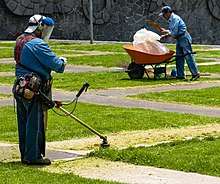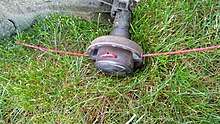String trimmer
A string trimmer, also called a "weed eater", "whipper-snipper", "weed-whacker", "weed-whip", "line trimmer", "brush cutter" (in Australia, New Zealand and South Africa) or "strimmer" (in the UK and Ireland), is a garden tool for cutting grass and groundcover which uses a flexible monofilament line instead of a blade. It consists of a rotating spindle from which the string protrudes, at the end of a long shaft with a handle. String trimmers are commonly used for cutting low foliage near obstacles or on steep or irregular terrain.
| Look up strimmer or strim in Wiktionary, the free dictionary. |

History
The string trimmer was invented in the early-1970s by George Ballas of Houston, Texas,[1] who conceived the idea while watching the revolving action of the cleaning brushes in an automatic car wash. His first trimmer was made by attaching pieces of heavy-duty fishing line to a popcorn can bolted to an edger. Ballas developed this into what he called the "Weed Eater", since it chewed up the grass and weeds around trees.
Design
A bump feed string trimmer works on the principle that a line spun fast enough is held out from its center (the rotating reel) very stiffly by centrifugal force; the faster the hub turns, the stiffer the line. Even round-section nylon line is able to cut grass and slight, woody plants quite well. Some monofilament lines designed for more powerful cutters have an extruded shape, like a star, that helps the line slash the material being cut; the line is thus able to cut quite large woody plants (small shrubs) or at least ring-bark them very effectively. These lines make disks less necessary for tough jobs.
The line is hand-wound onto a reel before the job is started, leaving both ends extending from the reel housing. The motor turns the reel and the line extends horizontally while the operator swings the trimmer about where the plants are to be trimmed. The operator controls the height at which cutting takes place and can trim down to ground level quite easily.
As the line is worn, or breaks off, the operator knocks the reel on the ground so a release mechanism allows some of the line in the reel to replace the spent portion. Newer models "auto-feed", where a small cutter ensures the exposed length does not exceed what can be swung efficiently. Newly extended line operates more efficiently because of its heavier weight and surface effects. The speed of the spinning hub is controlled by a trigger or throttle[2] on the handle.

A fixed line string trimmer has a trimmer head that takes pre-cut line inserts. There is no wound spool of line in the trimmer head, the user instead feeds the pre-cut line in to the appropriate slots. The advantages are that they're easier to feed line in to and troubleshoot than a bump feed system.
For vertical cutting the whole machine can be tilted or some trimmers allow the head to be adjusted at different angles. Vertical cutting is not recommended near sidewalks or other concrete and pavement edges, because it leaves open grooves that allow water to collect and cause damage.
String trimmers powered by an internal combustion engine have the engine on the opposite end of the shaft from the cutting head, while electric string trimmers typically have an electric motor in the cutting head, but there are other arrangements such as where the trimmer is connected to heavy machinery and powered by a hydraulic motor.
The head contains a safety shield on the user side and a rotating hub which may also be called a head or spool. Disadvantages of a gasoline-powered string trimmer include its greater weight and the significant vibration that carries throughout the device, both of which interfere with its maneuverability and contribute to muscle fatigue, as well as the requirement that motor oil be added to its fuel (if it is equipped with a two-stroke engine). Advantages of gasoline-powered trimmers include mobility (because they are not attached to a power outlet) and the higher maximum power.
Large trimmers, used for cutting roadside grass in large areas, are often heavy enough to require two hands to operate, and some are even fitted with a harness enabling the user's torso to bear some of their weight. These very large trimmers are often referred to as brush cutters. Brush-cutter types are usually made so a metal blade can be attached instead of the "string" (or monofilament). A metal blade enables cutting heavier woody brush.
Trimmers that have nylon or metal blades usually require straight driveshafts to handle the higher torque required to turn the heavier disk, and because of the shock loads that are passed back from the blade to the drive shaft and its gearbox(es). Smaller line trimmers have curved driveshafts to make holding the cutting-head at ground level much easier and with less strain on the operator.
Accessories
Many string trimmers allow the hub, the head or the lower part of the shaft to be replaced with accessories. Common accessories include:
- replacing the monofilament line with metal or plastic blades.
- replacing the lower shaft with a small chain saw to create a powered pole saw.
- replacing the lower shaft with a hedge trimmer.
- replacing the lower shaft with a cultivator.
Quick-release shafts are offered on many newer models which do not require any tools to switch in accessories.
Power and emissions
Gasoline-engine powered trimmers usually have a minimum of 21 cc displacement motors. At this size they can easily turn 2-millimetre (0.079 in) line and some have nylon blades as accessories to the line-reel. A 32 cc engine can swing a 2.75 mm (0.108 in) line and often has metal-blade accessories. Most trimmers use two stroke engines and require gasoline mixed with oil. Due to pollution laws four stroke engines are becoming more popular with a number of commercial weed eater models now being powered by four stroke engines. For instance, Honda, MTD and Craftsman manufacture a four stroke engine trimmer. Other companies, such as John Deere, now carry low-emission two-stroke engine trimmers. Stihl manufactures a hybrid four stroke engine trimmer using a technology called 4MIX. 4MIX trimmers have no oil reservoir. This engine is lubricated using pre-mixed gasoline, like a two-stroke engine.
Electric edge trimmers have the advantage of being very light, easy to maneuver and easy-to-operate devices. However, the length of power cord that can be deployed across the ground limits them, and they are usually less powerful and robust than the gasoline-engine ones. Electric machines normally are limited to 2.5 mm (0.098 in) maximum diameter nylon because of their lower power output (400 to about 1200 watts). There are electric string trimmers that offer the same performance as gasoline-powered trimmers. Recharge time for a battery model is typically several hours; some models offer a quick-charge option of as little as half an hour, or a removable battery pack.
The typical two-cycle engine used on string trimmers pollutes heavily due to incomplete combustion in the cylinder. This results in unburned fuel escaping through the exhaust system and into the environment. US emission standards specifically limit emissions from small engines. Electric models produce no emissions at the point of use. Battery-powered units typically use small or large sealed lead acid, nickel metal hydride, or lithium ion batteries.
Propane-powered string trimmers were also manufactured by Lehr.[3][4][5]
Environmental impact
Earth Island Journal criticised string trimmers as a source of plastic pollution due to the string being shredded while in use.[6]
Safety concerns
String trimmers can send debris flying at high speed, and in random directions. It is typical for the user to wear either safety glasses or a visor to protect their eyes (but not passersby). The debris can even damage cars and buildings, with a particularly high risk of broken glass.
Chain-link flail rotors, and any other trimmer head with linked metal parts, were prohibited from sale in the EU after a fatal accident in 2010.[7][8]
See also
- Brushcutter (garden tool), a heavy duty tool which may take a line trimmer head or various other blades
- Leaf blower
References
| Wikimedia Commons has media related to String trimmers. |
- Miller, Stephen (30 June 2011). "George Ballas, Weed Eater's Inventor, Dies at 85". The Wall Street Journal. Retrieved 9 May 2017.
- https://homeguides.sfgate.com/adjust-idle-weed-eater-85202.html
- Plueddeman, Charles (1 October 2009). "10 Most Brilliant Products of 2009: Lehr Propane Trimmer". popularmechanics.com. Retrieved 15 May 2020.
- Will, Hank (24 August 2009). "LEHR Propane Powered Eco Trimmer: Clean, Green and Mean". grit.com. Retrieved 15 May 2020.
- Neil, Dan (2 May 2009). "Yard work cleaned up". latimes.com. Retrieved 15 May 2020.
- Quinn, John (1 November 2013). "Strung Out". Earth Island Journal. Retrieved 1 November 2019.
- "Use of chain flail/non standard cutting attachments on brush cutters". www.hse.gov.uk. Retrieved 25 July 2016.
- "Anthony Robinson death: Firm fined over strimmer accident". BBC News. Retrieved 25 July 2016.